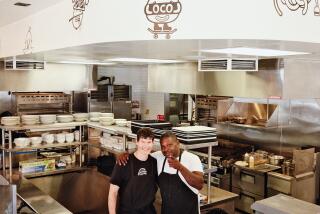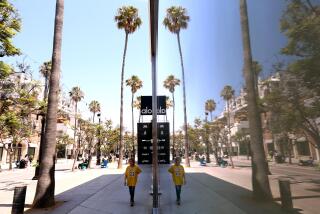Market Scene : Hong Kong Rips Up âCloth Alleyâ : The tourist landmark will soon be a wrap as the famed fabric shops are pushed out by urban redevelopment.
HONG KONG â Lo Yu-chong, 77, wraps yards of brightly colored fabrics and hands them to a tourist who is raving to her friend that she now can make five silk skirts for the price of buying one. Lo smiles and turns to beckon another passerby, hoping to strike up a deal on the last of his remaining stock.
Since 1941, Lo has earned his living selling fabric in Hong Kongâs Wing On Street--better known as Cloth Alley after the generations of merchants who have made this byway a center of the fabric business dating from the 19th Century.
Beyond its historical significance, Cloth Alley is an acknowledged tourist landmark--a classic example of what the Chinese call sing hong sing see (literally, same line same market) , or the practice of merchants in a similar commodity all setting up shop in the same area.
Nevertheless, Cloth Alleyâs merchants are now being moved out under the banner of urban redevelopment. In a test of whether tradition and redevelopment can somehow coexist, the authorities are offering some of those merchants new quarters on the west side of town. But Lo, for one, wonât be part of the experiment.
âIâm too old to consider alternatives,â he said. âBesides, I canât afford to move so I might as well retire once Cloth Alley comes to an end.â
Lo himself has served five decadesâ worth of Cloth Alley customers, from Japanese soldiers during World War II to todayâs bargain-hunting tourists. And the traditions of the street reach back to the last century, when Hong Kongâs waterfront bordered Wing On Street and merchants used to meet there to sell their fabrics to visiting sailors.
Today, a narrow path guides passersby through a block of ground-floor shops filled with bales of multicolored cloth that spill out into the crowded alleyway. Nylon canopies hang overhead between the low-rise buildings, allowing only scattered rays of natural sunlight to enter the street. Bare bulbs dangling from each shop entrance illuminate the path in a golden glow.
All very quaint--but also, very congested and even dangerous, declared the government, which two years ago approved an urban renewal scheme by the quasi-governmental Land Development Corp. (LDC) to redevelop a 2.5-acre area that includes Cloth Alley. The land beneath Loâs shop and those of his neighbors was literally sold out from under them to the LDC, which has launched eight urban redevelopment projects around the city since it commenced operations in 1988. In partnership with a local developer, LDC plans to turn Cloth Alley into a complex of commercial and office buildings around a central âgreen zoneâ to give Hong Kongâs residents a respite from what sometimes seems the cityâs never-ending concrete.
Owners of Cloth Alleyâs small shops were offered the opportunity to sell out to the LDC. If they refused, the government applied its âresumption ordinanceâ--something like the power of eminent domain--or condemned the buildings.
The shop that Lo rented has already been barricaded, forcing him to conduct his close-out sale in the narrow alleyway in front of the building.
Because the LDC considers Cloth Alley âan important tourist landmark,â it offered to relocate 18 of its 40 fabric shops to the newly renovated Western Market--a former meat and vegetable market turned upscale shopping bazaar.
There wasnât space available for all of them, explained Marina Lo, LDCâs senior assistant director of development. So those who took the corporation up on its offer âhad to draw lots to be fair.â
Lo wasnât the only merchant to reject the lottery.
Ho She So, who is scheduled to see his shop taken over by the government July 24, complained that in addition to the cost of the move, the rent and other expenses for a slot at the Western Market promise to be significantly higher for a smaller amount of space.
Others who have already made the move are less than enthusiastic.
âBusiness is not as good as in Wing On Street,â said former Cloth Alley denizen Yu Kwong Ling. âWing On Street is a convenient location for people working in the central part of the city,â while Western Market, opened last November, âis a bit out of the way,â Yu explained. âWeâll have to wait and see.â
Others complain that their new surroundings lack the vitality of noisy, lively Cloth Alley.
âBut the Western Market is a building, not a street,â commented LDCâs Lo (who is no relative of the cloth merchant). âI can never create another Wing On Street.â She says the cloth merchants need a change of attitude and more aggressive marketing.
âCloth Alley operators do not like to generate business. They have a sort of Chinese, old-style method of doing business and prefer to wait for customers to come to them,â Lo said. âBut they canât rely on the LDC to promote Western Market. . . . Everybody has got to do their own business promotion. That is the idea of business.â
Lo said the cloth merchants should consider themselves lucky that they have Western Market as a springboard for future business. âThe LDC canât do Western Market for every single trade that is worth preserving. . . . I hope the Cloth Alley operators stop complaining about what we havenât done and start thinking more about what we have done,â she added.
But to aged cloth merchant Lo Yu-chong, the changing of places and ideas means the sad end of an era in Hong Kongâs history.
More to Read
Sign up for Essential California
The most important California stories and recommendations in your inbox every morning.
You may occasionally receive promotional content from the Los Angeles Times.










